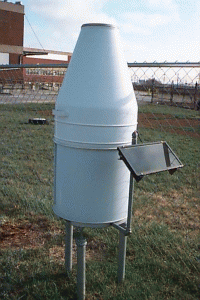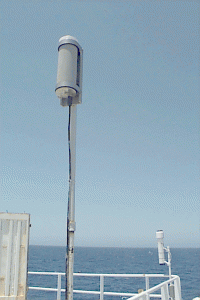German Weather Service meteorologist Christoph Hartmann writes what I think is a surprising essay on measuring precipitation, and the errors in doing so. Indeed Hartmann says precipitation may be understated by up to 50%, or much more at some locations.
As Hartmann explains, measuring precipitation is by no means an exact science, and results have to be taken with a lump of salt.
There are many sources of errors, and in his essay here he looks at just two main sources: wind and instrumentation.
But first, let’s take a look at how precipitation is measured. In his previous essay he described two types of precipitation measuring gages. In Germany precipitation is measured with the unit of liters/m², e.g. 25.4 liters is an inch of rain.
Two methods of measuring precipitation
Hartman explains that precipitation is generally measured by a rain gage with a known opening area, for example 200 cm² in Germany, which is positioned 1 meter above the ground surface. The gage funnel catches the precipitation and leads it to either
1) a graduated measuring tube or a
2) an optical drop counter
With the measuring tube system, the tube is graduated and the amount of precipitation can be simply read off. With the optical rain gage (drop counter), the amount of precipitation is derived from the number of drops. If the precipitation is snow or ice, then the measuring tube or optical gage are brought inside and the captured precipitation is melted and measured.
Hartmann explains that the biggest sources of error are wind-related. This is easily seen when measuring snowfall. Just before a snowflake falls into the gage, air turbulence sucks it back out tosses it overboard. Just taking a look around after a blizzard, it’s easy to imagine how difficult it is to measure snowfall. Places exposed to wind are barren, while other places are covered by meter-deep snowdrifts. How much snow really fell?
Hartmann says measurement errors of up 400% can occur over time when measuring powdery snowfall in alpine, polar or windy areas.
One way to reduce error is to place the instrument in a wind-protected area. By measuring the wind speed, it is then possible to adjust precipitation measurements. But Hartmann writes:
Wind effects lead to an under-estimation of the actual fallen precipitation. The level of deviation depends on the speed of the wind and the type of precipitation.
Because wind speeds are factored into precipitation measurements, climatological precipitation trends without taking changes in wind speeds into account should always be deduced very carefully.
The second problem encountered arise from the two above described measurement instruments, especially with the optical rain gage, writes Hartmann. With frozen precipitation, the gages are heated up in order to melt the precipitation. But this involves evaporation. And under torrential rains, the optical gage becomes much less accurate. The result, writes Hartmann:
Under equal precipitation amounts, the optical gage measures less precipitation than the measuring tube, both in summer and in winter.
So if two different stations use different instruments, them they will show different precipitation amounts even when the actual precipitation is the same. In summary, Hartmann writes his stunning conclusion:
In total these two sources of errors lead to a precipitation deficit of 5 to 15% for liquid precipitation, and between 20 and 50% for solid [frozen] precipitation. In very windy locations, the deficits are substantially more.
Because instruments measure less precipitation than what actually falls, it means we have a worldwide precipitation deficit solely because of the measurement method.
What does it all mean? Are many of the reported droughts solely the product of faulty readings? And we all thought that the network of temperature measurement stations was a mess. This is a huge open floodgate to potential climatological data manipulation and bogus assertions. See here for example: motherjones – the coming mega-drought (h/t NTZ reader DirkH).







I’m not sure if this entirely relevant, but my father has two rain gauges.
1) A calibrated measuring tube (like the one shown in this post) and
2) A “tipping bucket” device which is part of a multi sensor weather station (made by Irox)
These are mounted side by side, at the same height on a post in the garden. Both give exactly the same readings in anything from drizzle to a torrential downpour. The only variation we’ve noticed is during occasional light rain showers when the tipping bucket may not register before conditions dry up.
It looks like the warmists come out of their holes in the run-up to Cancun. There have now been many days when i didn’t find any warmist propaganda on the German frontpages, but now, two at the same time.
Two British gravy train riders given space in Die Zeit; generic alarmism piece:
http://www.zeit.de/2010/43/P-Klimawandel
(I think Die Zeit is digging themselves a hole ATM.)
American study about droughts (and the projected increase thereof; if IPCC models are what you would trust in.) linked on the main page of t-online:
http://nachrichten.t-online.de/forscher-erwarten-beispiellose-duerren-auch-in-deutschland/id_43210048/index
I wonder why they need the public opionion; after all, the Climate conferences aren’t democratic anway.
For comparison, here’s a warmist English-language writeup of the NCAR drought study:
http://motherjones.com/kevin-drum/2010/10/coming-mega-drought
Drought?
Like Hartmann says, it’s a product of really crappy measurement techniques. And at Die Zeit, you only need to bring up the record low ACE to shoot down their stupid, ever nearing catastrophe claims.
Played with the wetterdienst site you linked to. As they are federally funded, they should be expected to be on message, and indeed they are. Compare current temperature to “usual anomaly”, and include a projection into the future, gives the funny result: NOTHING happened in Germany since 1900 but steep warming will happen REAL SOON NOW!
http://www.dwd.de/bvbw/appmanager/bvbw/dwdwwwDesktop?_nfpb=true&_windowLabel=T174000156471277448320607&_urlType=action&_pageLabel=dwdwww_klima_umwelt
All i can say is, glad i get such nicely done scare stories for my taxes.
[…] Huge Global Precipitation Deficits Due To Woefully Inaccurate Measurement Techniques! […]
I seem to remember a recent WUWT blog where the Australian weather service adjusted the historical precipitation chart down. http://wattsupwiththat.com/2010/10/15/bom-disappears-rainfall-data-no-trend-becomes-downtrend/ I suspect intentional human error may be another leading factor in missing precipitation.
How and why did doubt/denial of global warming become associated with right-wing political platforms?…
The studies on infrared radiation and the upper atmosphere can not be accounted for. Firstly, while it is true the upper atmosphere is cooling, and that is a sign of AGW, the study is flawed. It does not take into account short term radiation, or sunli…